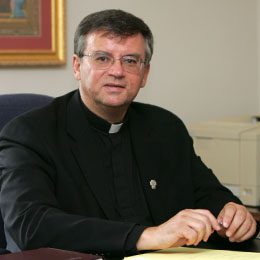 Prayer Service at Beatification for Spanish Martyrs
Prayer Service at Beatification for Spanish Martyrs
October 11, 2013
“No Greater Love”
“No one has greater love than this to lay down one’s life for one’s friends.” (Jn 15:13)
There is a reason that the cross is the great Christian symbol. As the two beams of the cross intersect, they bring together death and the gift of life; they reflect sin and its forgiveness; they combine violence with a peaceful self-surrender; and the human encounters the divine. At the center of all these truths, one finds Christ who unites and gives meaning to all in love. We cannot fully grasp our faith unless we understand it at the foot of the cross. Paul reminds us “For I resolved to know nothing while I was with you except Jesus Christ, and him crucified” (1 Cor 2:2). To know Jesus is to understand the cross. Yes, and to understand the cross is to know the heart of Jesus. The meaning in martyrdom flows from the acceptance of the truth of Christ’s sacrifice on our behalf.
Let me select three statements which Jesus makes around the cross and allow them to give direction to our reflection on martyrdom this evening.
First of all, Jesus tells his disciples:
“If anyone wishes to come after me, he must deny himself and take up his cross daily and follow me.” (Lk 9:23)
For Jesus, the cross was the symbol of his total surrender of himself to the will of the Father. Jesus wanted each word that he spoke and each action which he did to be in accord with what the Father asked of him. He carries out this practice during the whole course of his ministry and this surrender reaches its fulfillment in the total gift of his life on the cross. Jesus holds out this goal of self-surrender to the will of God to each of his disciples.
As we remember our martyrs today, we recognize how they welcomed the call of Jesus to its fullness. The simple ministries which each of them carried out on behalf of their brothers and sisters—especially the poor—were expressions of their appreciation of God’s will for them. To remain faithful to their service and their vows, they were willing to follow the call of the cross to its conclusion. Like Christ, they embraced the cross as a consequence of their faithful living each day.
A second statement of Jesus around the cross is this:
“This is my commandment: love one another as I love you. No one has greater love than this, to lay down one’s life for one’s friends.” (Jn 15:12-13)
Jesus did not come among us to suffer and die, but to show us the way which leads to the Father without compromise. For this purpose, he was willing to suffer and die. He wanted to demonstrate God’s love for us by showing us his love for us to the end. One of the most powerful lines in the Gospel of John reminds us that:
“God so loved the world that he gave his only Son, so that everyone who believes in him might not perish but might have eternal life” (Jn 3:16).
God’s love for us as demonstrated by Jesus was so great that he was willing to give his very self to show us the way until his last breath. Nothing prevented Jesus from making God’s love and God’s way clear for us. There was no holding back. We are truly the friends of Jesus, as Jesus demonstrates throughout his very life.
For some Christians, that invitation is offered literally: to take up a willingness to suffer and die for the sake of Christ in order to give witness to his life. Our martyrs demonstrate how well that they have learned this lesson. Remembering that Jesus suffered and died for them in order to show the way, they have followed his example and been willing to suffer and die to continue to show the way to us. There is a well known and true statement from the Church Father Tertullian which has encouraged generations of Christians: “the blood of the martyrs is the seed of the Church.” We should reflect on the truth of this quotation today. The example of our sisters and brothers who were willing to sacrifice their lives for the truth of the Gospel and the faithful following of Jesus needs to be a witness for each of us and an encouragement to live our charism and faith with greater devotion. We do this for our friends.
One last statement of Jesus regarding the cross can be mentioned here. He said that:
“No one takes [my life] from me, but I lay it down on my own. I have power to lay it down, and power to take it up again.” (Jn 10:18)
At the heart of the action of Jesus is his freedom and willingness to give himself for our sakes. He was not taken from among his disciples because of brute force. He could have avoided the confrontation by hiding or softening his message (or calling upon the hosts of heaven), but that was not why he was sent by the Father. He wanted to witness with all clarity and richness to his message and ministry; when it came to laying down his life, he was willing to do so in freedom and obedience. His life was not taken from him for our sake; he gave it willingly for our sake.
This is also true of the martyrs. There are usually ways of avoiding martyrdom: one can run or deny one’s faith. In order to live faithfully, however, one must be willing to stand up and bear witness to what one believes until the end. This is not to say that one is not afraid— in the Garden of Gethsemane, even Jesus demonstrated that he was not eager to suffer and die (Matt 26:39, 42)—but despite one’s fear, one is willing to remain faithful. In the end, the martyr lays down his or her life willingly for the sake of the faith.
A genuine connection exists between the cross of Jesus and the cross of the martyrs. In the Book of Revelation, a very suggestive passage describes those who are dressed in white before the heavenly throne and the Lamb of God:
“These are the ones who have survived the time of great distress; they have washed their robes and made them white in the blood of the Lamb.
“For this reason they stand before God’s throne
and worship him day and night in his temple.
The one who sits on the throne will shelter them.
They will not hunger or thirst anymore,
nor will the sun or any heat strike them.
For the Lamb who is in the center of the throne will shepherd them
and lead them to springs of life-giving water,
and God will wipe away every tear from their eyes.” (Rev 7:14-17)
These are the martyrs—intimately connected to the passion of Christ. The imagery is striking: “They have washed their robes and made them white in the blood of the Lamb”. “Blood,” of course, is the symbol of sacrifice and human life; “white” is the symbol of victory and eternal life. One flows from the other.
Martyrs! As many of us know, the root of the word “martyr” in Greek means to “witness.” Those who accept the crown of martyrdom “bear witness” to Jesus and to their faith. It is a powerful word and a powerful testimony. The concept of martyrdom is filled with contrary notions: faithful men and women surrender themselves to death in order to affirm life; they undergo violence in order to witness to peace; they resist hatred in order to offer the forgiveness of love.
Jesus showed the way and our martyrs demonstrate that they have learned the lesson. They were willing to follow till the end. As we remember these faithful sisters and brothers in these days, we can pray that their blood may be for us the rich seed which Tertullian promised. They witnessed to the truth of the Gospel and, in particular, its strength within our Vincentian charism. Vincent and Louise would joyfully recognize these women as sisters, and these men as brothers. We should as well. We pray today that the remembrance of their deaths may be for each of us, and the Church of Spain, as well as the Church throughout the world, a fertile source of growth in our faith.
Tags: Griffin, Vincentian Martyrs

